Product Review - Denon DVD-1600
DVD-V/DVD-A Player - Part 2 - June, 2002
John E. Johnson, Jr.
![]()
Now that I have heard both SACD and DVD-A, I am convinced that this is the way all music should be recorded. There are factions who believe that one sounds better than the other, but for me, I just enjoy the heck out of both of them. It is really too bad that DVD players in general are not being given the freedom to have both formats decoded on a single player and that neither will allow digital output to the receiver. As a result, we need two different players if we want to listen to all the disc formats. They both sound so good, I have sprung for getting two players, and fortunately, they are relatively inexpensive. The Sony SCD-CE775 SACD player is less than $200, and the Denon DVD-1600 DVD-V/DVD-A player is about $500. The Sony does not play DVDs, but as you will see below, I am making the Denon DVD-1600 my reference DVD player because it passed just about every one of our Benchmark tests. So, between the two players, all formats are covered.
DVD-A is so much better than CDs, it is a shame we can't just go right to such a high resolution audio format instantly, and stop producing conventional CDs. Even just a two-channel DVD-A is better than any $10,000 CD player I have ever heard. One bit of good news here is that two-channel 24/96 audio DVDs are gaining in numbers, and they will play on any DVD player that has 24/96 DACs (most new ones do have them). It does not have to be specifically a DVD-A player. The reason for this is that two-channel 24/96 discs fit within the DVD-V specification, so they are recognized by standard DVD players. This is one way you can try out the high resolution audio sound quality without investing in a new player that is labeled DVD-A. A good source of these discs is Hi-Res Music (http://www.hiresmusic.com/homepage.html). Be sure to select among the discs that are remastered from analog tapes rather than remastered from 44.1 digital recordings. You will discover, as I did, that 24/96 approaches the true analog sound, like our old LPs, but without the scratches, pops, and ticks that plagued phonograph recordings.
For example, I used several 24/96 remasters of decades-old jazz recordings, and the depth of the sound is just incredible. The harshness and edginess that seems to be a part of 16/44 CDs is just not there anymore. But, it goes way beyond that. The soundstage has more body. The musicians seem closer, almost sitting next to me. Instead of just hearing music, it is more like you can see the musicians too (actually, you can see them on some DVD-As, which include video). CDs are getting harder and harder to listen to. DVD-A and SACD can count me in for good. Here are the 24/96 discs that I used for this test.
Multi-Channel DVD-A is a completely different animal than CD, and is impossible to compare. There are two-channel diehards out there who will never succumb to the call of surround sound. But, they will succumb to two-channel 24/96 once they hear it. With DVD-A surround sound, it all depends on how the sound was mixed. For awhile, we are likely to have some discs that just try to impress with sound coming from everywhere, bouncing to and fro. Once that is over, we will have music that immerses and surrounds, but does not throw your sense of balance out of whack. This will not be easy, because we are not used to having music come from behind us. Movies? Sure. The jet flying overhead, dog barking in the rear. But music? We will see. In any case, the effects of having five discrete channels of high resolution music are beyond words. I have experimented with seating, and I have found an interesting sensation when in a reclining position in my favorite chair, placed in the center of the room.
The video from the 1600 is crisp and clean, with no combing. I just wish we could get multi-channel DVD-A or SACD type soundtracks, to go with the movies. DD and DTS are compressed. But, all of that would not fit on a DVD. We will have to wait until HD-DVD for such capabilities (and possibilities).
On the Bench
Audio
The frequency response for CDs is smooth from 20 Hz up to about 7 kHz, when it begins a slow drop out to 20 kHz, but is only 0.25 dB down at that extreme. With 24/96 signals, I measured a response that was down 0.1 dB at 24 kHz, and down 1 dB at 48 kHz. This is quite good, but I feel that the increased frequency response is not the real selling factor for DVD-A. The increased bit depth results in a better sound at all frequencies, including the midrange areas where our ears are most sensitive.
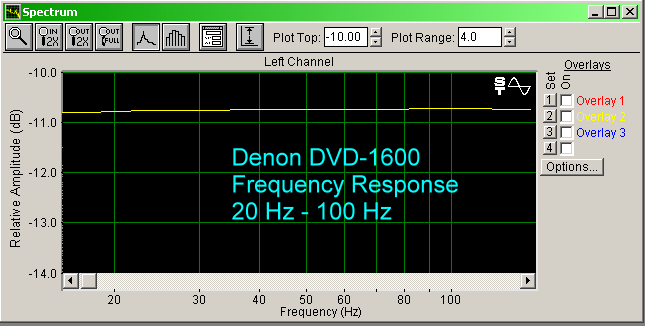

Distortion measurements showed some nice results too. Using a commercial CD test disc (CBS), and an SMPTE standard 11 kHz and 12 kHz sine waves, you can see that the 1 kHz and 2 kHz IMD peaks are about 100 dB below the main input peaks. Larger peaks are out of the audible band, and these are between 60 dB and 80 dB below the input peaks.
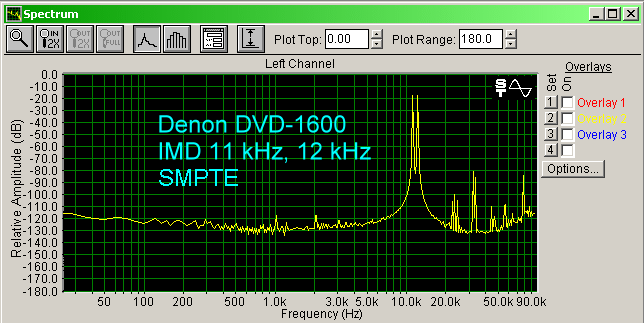
I also used a CD test disc that I made here in our labs, with 11 kHz and 12.1 kHz tones, dithered and recorded at - 20 dB. (My software for generating multiple dithered tones limits me to 0.1 multiples of the fundamental, which in this case is 1.1 x the 11 kHz.) These are at levels more likely to be encountered during normal listening. You can see that the IMD is lower than with the SMPTE signals. These represent lower distortion values than I have seen with older CD players, indicating the value of having not only better DACs, but better Op Amps.
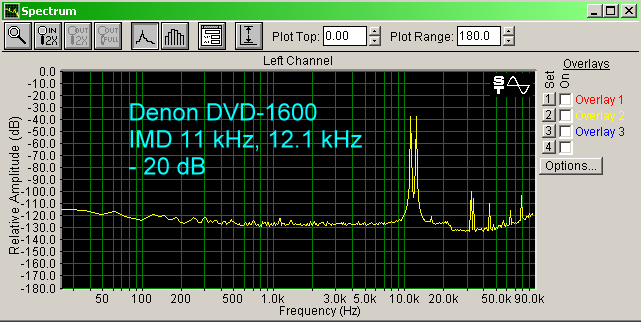
Video
The video performance of the DVD-1600 is remarkable. Below is a table of results on our Benchmark tests.
| Product | WF1 | WMM | WC1 | WC2 | VZP | BL | GQM | GQT | MT | A13 | BC | SS | A |
| Denon DVD-1600 DVD Player |
|
|
|
|
|
|
|
|
|
|
|
|
|
You can see that it passed just about everything, and the one problem it had was very minor.
Our "Toy Story" test result is shown below. Notice how the junctions between the red and blue areas of the toy box are smooth. No chroma bug!! This is a closeup of the projection screen, and you can see the individual pixels from the LCD projector panels. Those are not part of the movie image.
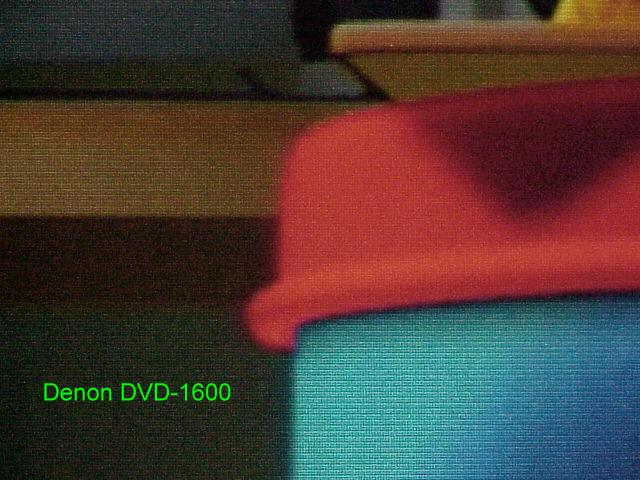
The Snell & Wilcox Zone Plate Test was just as impressive (shown below). While the round disc on the right was moving, the high resolution bars on the left (pink arrow) stayed sharp. This means good motion-adaptive algorithms. The DVD-1600 uses DCDi technology from Genesis-Sage-Faroudja. This makes moving diagonal lines not have the jaggies. It worked perfectly here.
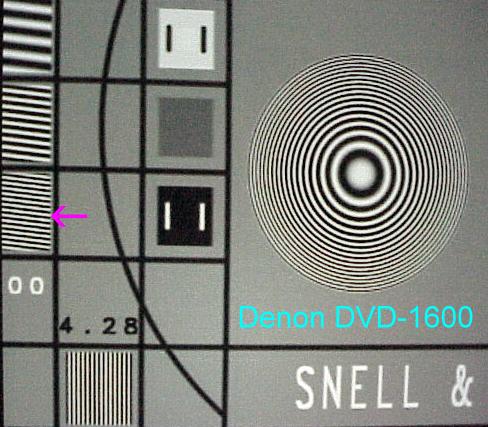
The resolution test results are shown below. With the 6.75 MHz circle of vertical lines (pink arrow), all lines were sharp, indicating a full resolution. Using the Cinema button on or off did not make any difference in the sharpness of this image, nor did it affect the resolution. I do this test with the player in interlaced mode. Keep in mind that the most accurate way to measure resolution is with a scope. These screen shots are only generalizations, and I have to use the interlaced output with the 10HT due to aliasing problems that occur with digital projectors.
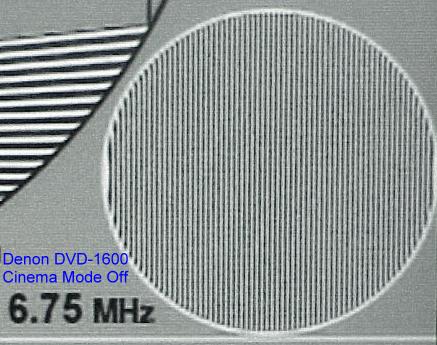
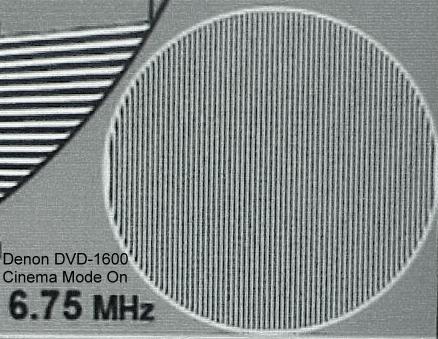
This contrasts with a recent player, the Toshiba SD-K700, which has less resolution. These differences are at the upper end of the resolution spectrum, and really not all that evident when watching movies. But the difference can be seen in a test pattern like this one.
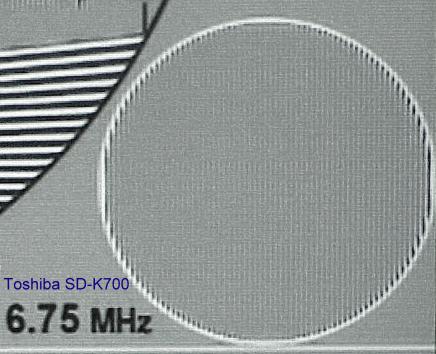
Conclusion
If we can get past the competitive problems between SACD and DVD-A, and feed the signal digitally to our receivers, high resolution audio will be very successful. In the worst case, the music will trickle in, and we will have to buy two players. The good news is that it is not very expensive to have two nice players. The Denon DVD-1600 has excellent DVD-A quality, and our Benchmark tests indicate that it is one of the best DVD Video players on the market. For those of you who have been asking us about which new DVD player has superior performance, and NO chroma bug, your wait is over.
- John E. Johnson, Jr. -
![]()
© Copyright 2002 Secrets of Home Theater & High Fidelity
Return to Table of Contents for this Issue.

